How to Install a Downspout to an Existing Gutter
How To Cut & Install Downspout & Gutters for Beginners
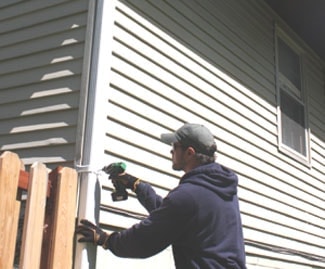
Install it yourself to protect your home and save on labor cost.
In general, gutters and downspouts are far from the most glamorous feature of a home, but these systems are the unsung heroes that protect your house from water damage. By collecting roof runoff and diverting it away from the building envelope, gutters and downspouts help to prevent damage such as wood rot, mold and mildew.
The house shown in this article was built in 1978 and only had a single gutter and two downspouts installed at the front, with nothing on the rear. As a result, during a rainstorm the water was cascading off the rear of the roof and pounding a trench along the foundation wall, where it was seeping through the ground and migrating through the cinderblock, as evidenced by water stains on the interior of the wall. By installing a gutter and a couple of downspouts, the water is channeled away from that troublesome trench and diverted across the yard and away from the house walls.
Professional installation of metal gutters usually involves specialized equipment used to form gutters from sheet metal at the job site. One advantage of professional installation is that the gutters can be installed with a seamless system, which provides the best protection against leaks. Plus, the gutter contractor will be the guy working atop a ladder at the roof line, which is a big selling point for homeowners who aren't comfortable with the heights of roof work. However, for do-it-yourselfers who don't mind working on a ladder, you can save considerable labor costs by installing a gutter using the sectional systems available at retail outlets such as Lowe's Home Improvement Stores.
For this particular job, I picked up the materials at my local Lowe's, which distributes Amerimax aluminum gutter systems. The first step is to sketch out your gutter system on paper so you can quantify the various components required. Measure your roof line and wall height to calculate the number of 10-foot sections of gutter and downspout you'll need. I was working with standard 5-inch gutters with a "K" profile. Next, account for end caps, seamers, inside or outside corner pieces, downspout elbows and end drops. You'll also need mastic for sealing the joints, downspout bands to fasten to the house, and sheet-metal screws to connect the downspout sections. To hang the gutter, you can choose from a variety of fastener types. I chose to use hidden fasteners that are held to the fascia with screws. Here's how a homeowner can install a gutter, protect their home and save some cash by doing it themselves …
Getting Started
When installing a gutter system, be prepared to spend a lot of time working at potentially dangerous heights. Because so much roof work is involved, I highly recommend attaching a ladder stabilizer to the top of your ladder. I picked up a Werner Ladder Stabilizer at Lowe's, which proved on this job to be the best 25 bucks I could have spent. Not only does this simple bracket attachment safely prevent the ladder from swaying from left to right while you're standing on it, but it also provides a 10-inch standoff from the roof line, which makes it easy to access the fascia and gutter without obstruction from the ladder. The stabilizer also rests on the roof, rather than on the shingles, fascia or house siding, so there's no worry of accidental damage from contact with the ladder.
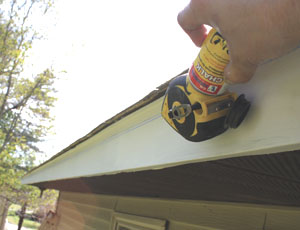
To begin installation, safely position the ladder on even ground with the ladder stabilizer firmly supported by the roof deck. Climb up to one corner and hook the end of a chalk line at the point where you want the top edge of the gutter to terminate. Unreel the line as you move to the opposite end of the fascia. At that corner, first level the string, and then drop the string about 1 inch per 40-foot run and snap the chalk line. This achieves a slope that helps gravity pull water to the downspout locations. If you have a long run with downspouts at both ends of the gutter, you can slope the gutter from its midpoint toward both of the book-ending downspouts.
Preassembly
Even when using a ladder stabilizer, the safest and easiest way to work is to assemble as much of the gutter system on the ground as possible.
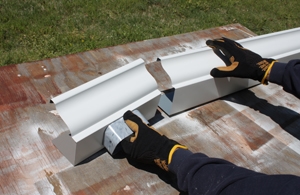
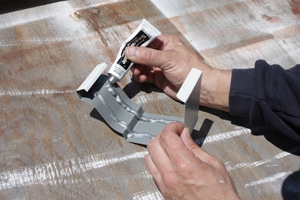
I designed this particular gutter system to have a downspout at each end, which required an "end drop" at each downspout location. To join the end drop to the gutter—or to join any gutter section to another—requires a "seamer." The seamer is a 3-inch wide piece of aluminum in a "K" profile to match the gutter. First, apply gutter sealant or mastic to the top side of the seamer piece. Then, wrap the seamer around the butted gutter components from below. The front of the seamer hooks to the front edge of the gutter. The rear of the seamer extends above the rear of the gutter, and you fold this extended flap of metal over the rear edge of the gutter. Use pliers to crimp both the front and rear lip of the seamer tightly onto the gutter. Then, cover the visible seam inside the gutter with a generous bead of mastic.
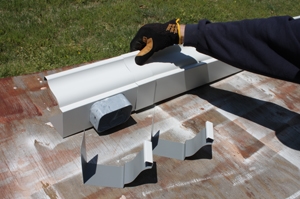
The various gutter components are connected with aluminum seamers and gutter mastic.
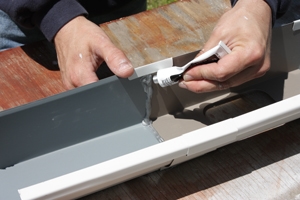
With the end drops positioned over the corner of each wall, I still had 12-1/2 inches of gutter between the end drop and the end of the roof. This required cutting a short section of gutter, seaming the piece onto the end drop, and then applying an end cap using the gutter mastic. Before installing the gutter section, give the mastic a few hours to dry and gain some rigidity at the joints.
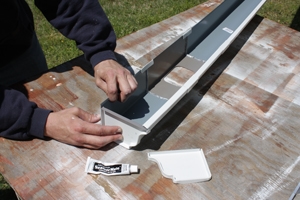
An end cap ensures the water exits the gutter in a controlled flow through the downspout.
Cutting to Size
When assembling the gutter and downspouts, you will likely have to cut some of the materials to length. One basic method is to clamp the material firmly to a couple of saw horses and cut using a hacksaw. A good pair of metal snips can also do the job.
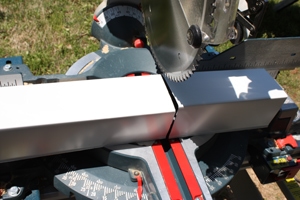
Either of those methods works fine, but I used a sliding miter saw with a fine-toothed blade turned backwards. The speed of the blade combined with the backwards teeth make a nice, clean cut with very little operator effort. Note: When cutting gutter material on the miter saw, turn the section upside down so the cut enters the more stable underside of the gutter rather than the top edges.
Fasteners
Gutter fasteners come in a wide variety of styles and shapes. Some of the options include screw and ferrule, fascia brackets, roof hangers with strap, or hidden hangers—the kind I chose. The hidden hangers clip over the rear edge of the gutter and hook beneath the front lip. Each hidden fastener comes with a 1/4-inch hex-head screw that you power drive into the fascia board to hang the gutter.
I pre-attached the hidden hangers while assembling the gutter section at ground level. Simply clip them in place every 2 feet along the length of the gutter section. Make sure to locate a fastener near the end of each section to minimize stress at the joint locations.
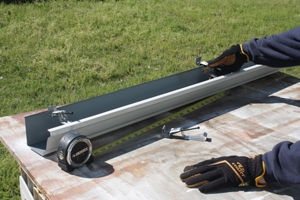
Install hangers every 24 inches along the gutter.
Hanging it Solo
As is usually the case, I was working without any help, but if you can recruit a friend or neighbor to help install the gutter then I suggest doing so. Although the gutter sections are surprisingly very lightweight, they can be rather cumbersome for a single individual to carry up the ladder and nail in place. But that's what I did.

To install the first section I placed the ladder on the roof about midway of where the first section would be installed. I hauled the gutter section to the top, positioned the end about 1 inch beyond the roof line, and—holding the section from the middle of the gutter—I slightly tilted it so its top edge matched the slope of my chalk line. I then zapped in the screw of the center fastener.
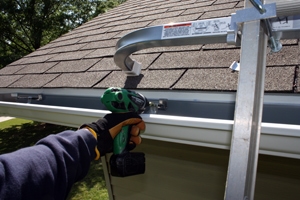
The aluminum gutters are so lightweight that a single screw will hold the section temporarily in place. By having the center screw secured, I had a pivot point where I could more accurately position the gutter along the chalk line and drive home the remaining screws to anchor the gutter.
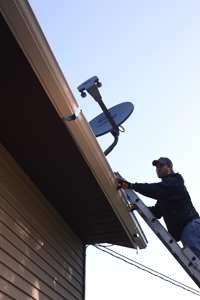
And, that's pretty much the basics of hanging the gutter: Rinse and repeat. Start at one end and work toward the opposite, assembling as much of the gutter on the ground as possible and securing it with fasteners at the roof line. The only difference is that you will have to seam together the separate gutter sections at the roof line rather than on the ground.
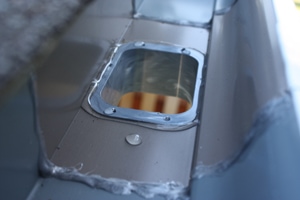
The flange is secured in the end drop with gutter sealant and screws. (Screws not pictured.)
Downspouts
Once the gutter was completed with end drops located at each wall corner, I then assembled the downspouts. To do so, I temporarily duct-taped an elbow to the flange outlet of each end drop. (The flanges are secured to the end drops using mastic and sheet metal screws.) I used a straight edge to follow the trajectory of the elbow toward the wall where the second elbow would be located. I then temporarily taped the second elbow to the wall. Next, I used a ruler to measure the downspout section I needed to install between the two elbows.

I used a straight ruler to measure the downspout needed between two elbows.
Note that each downspout and elbow has one end crimped. The parts are joined by fitting the larger end of one over the smaller end of the other. In other words, downspouts are connected using a slip joint (not a butt joint like the gutters), so be sure to account for the overlapping slip joint when measuring—usually 1 inch of downspout overlapping the elbow at each end.
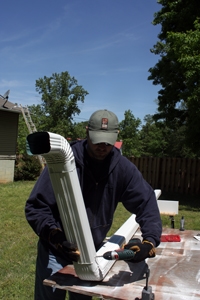
The downspout sections connect with slip joints, each fastened with at least two aluminum screws driven into predrilled holes.
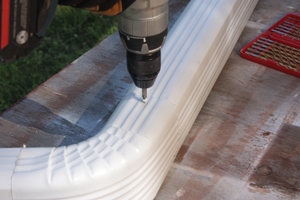
Assemble the downspout at the ground level, driving primed sheet-metal screws into predrilled holes at each joint in the downspout. When assembling, be sure to orient the successive pieces so the upper elbow or downspout section always tucks into the lower section—rather than the other way around, which will ensure a leak. Use two screws per joint.
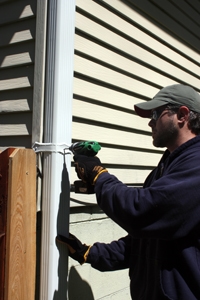
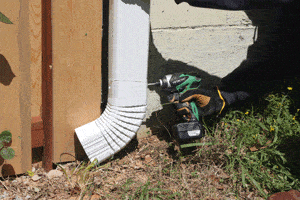
Fasten the downspouts snugly against the wall, with two flexible aluminum downspout bands per 10-foot section using nails or screws. A little temporary duct tape helps to keep the downspout stationary while fastening.
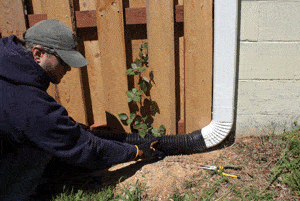
Finally, attach a front or side elbow at the downspout's bottom to direct water away from the building foundation.
Cover up for Easy Maintenance
Gutter protection is a hot item among the many homeowners who groan at the prospect of climbing onto the roof to scrape muck out of their gutters. The idea behind these products is to prevent leaves and other debris from accumulating in the gutter system, which can cause blockage and in some areas lead to ice dams. Here are three different designs to consider when selecting a gutter protection device.
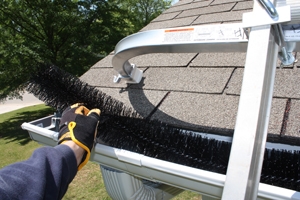
LeafBlox
LeafBlox is a product that the EHT staff affectionately refers to as "fuzzy caterpillars" or "big pipe cleaners." That's what they look like anyway, but this interesting design for a gutter guard costs a fraction of many competitive systems and provides 360-degree internal protection to block leaves, branches and other debris, including nesting birds, insects or squirrels from getting into your rain gutters. Simple to install by hand, the LeafBlox product also prevents standing water in your rain gutters that can be a breeding ground for insects and disease. Visit www.leafblox.com.
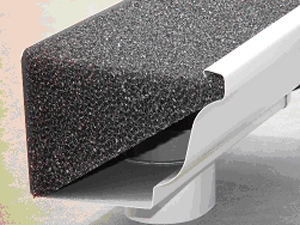
Gutter Filler
Gutter Filler is a porous, foam-like product that fits popular gutter sizes and styles. Each style is cut to fit inside your gutter and seals out all debris, while allowing water to quickly flow through it. Gutter Filler fills your gutters and utilizes the entire surface area of your gutters to capture all of the water. It can handle water flows of up to 24 inches per hour, and it all goes into your downspout. The product screens pine straw, maple whirlies, seeds and small pieces of debris that tend to get into your gutters or entirely block your covers and screens, preventing any water from entering the gutters. Gutter Filler also stops mosquitoes from breeding in your gutters by preventing access to water, and it includes built-in BioCide to stop the growth of moss, mold and mildew. Gutter Filler comes with a 20-year, no-clog guarantee. Visit www.gutterfiller.com.
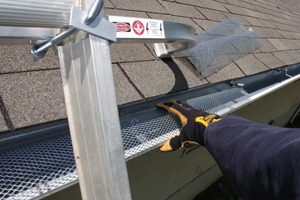
Gutter Guard
Gutter Guard from Amerimax is a system of hinged metal covers with a convex design that covers both the gutters and the edge of the roof to prevent leaves, twigs and other debris accumulation. Made of galvanized steel, aluminum, copper or powder-coated steel, the Gutter Guards simply snap onto the front edge of the gutter using hinged stainless steel clips. The guards install in seconds with the push of the thumb, and if there ever is a need to clean them, just flip up the guards at the hinge for easy gutter access.
SIDE NOTE 1
Questions on Corners?
The installation shown in this article is pretty straightforward, with no corners to overcome during the project. However, creating corners is easy with sectional gutter systems. The corner sections are sold as pre-manufactured components: both Outside Miters and Inside Miters are available, so you don't have to worry about seaming a 45-degree cut. All that's required is careful measurement of the components, and then to seam the two butted square sides of the miter piece into the gutter run as usual.
READER TIP:
Use Auto Undercoat
A quick tip to ensure the seams seal and don't leak over time: Go to the local Automotive parts store and purchase a spray bottle of automotive undercoat. It's a tar-type product in an aerosol can. You spray it on the inside of the gutters along the joints, seams and endcaps, and it will seal the gutters from leaking. The product is designed for temperature extremes so heat and cold do not cause it to crack or shrink over time. Thus, really only one application is needed. It also doesn't add to the buildup at seams/joints, so you don't have additional places for debris to collect and restrict water flow.
—H. Lewis, Jefferson, TX
SIDE NOTE 2
The SpoutOff
Homeowners can now be certain that rain is flowing from their gutters without climbing a ladder!
Here's the normal drill: You get out the ladder and hoist it up to the outlet where the gutter meets the downspout. You look in, grab the muck and throw it to the ground. Then you climb down the ladder and do it again and again at every outlet.

Now, with the SpoutOff, all your outlets can be kept clean and flowing without a ladder. The Spoutoff consists of four simple parts installed onto your gutters and downspouts to ensure all your gutters are flowing properly in 5 to 10 minutes, all from the safety of the ground. The Spoutoff enables you to take your 1-, 2- even 3-story downspouts off your house and clean out the outlets from the ground. No tools are needed. It takes less than a minute to check and clean a Spoutoff outlet. Plus, a single-story Spoutoff downspout only weighs about 3 pounds, the 2-story about 6 pounds, and 3-story about 9 pounds. The Spoutoff can be installed with new rain gutter systems, or it can be retrofitted onto present gutters and downspouts that are in good condition. Visit www.thespoutoff.com.
Recommended Articles
How to Install a Downspout to an Existing Gutter
Source: https://extremehowto.com/gutters-downspouts-for-the-diyer/